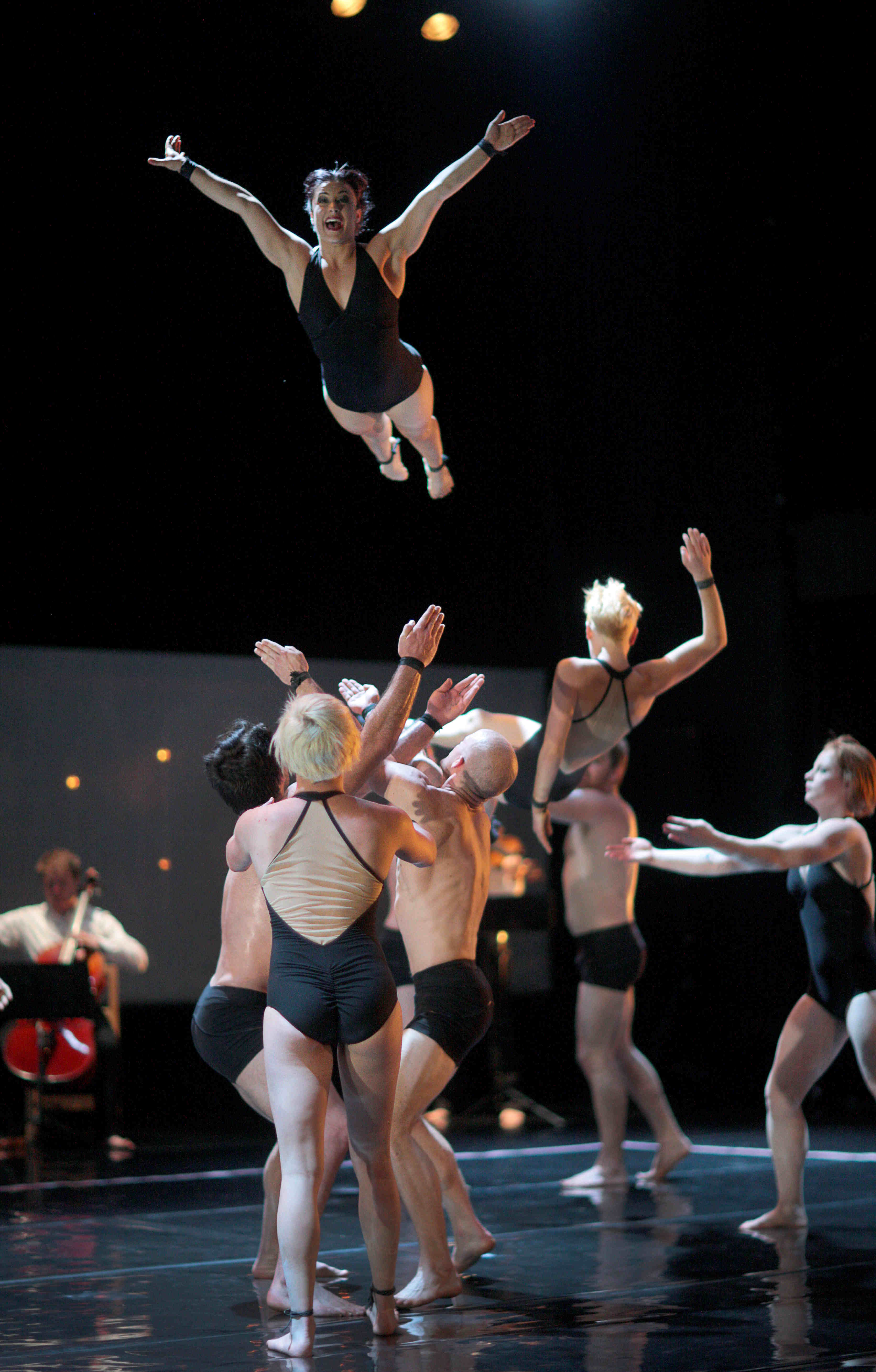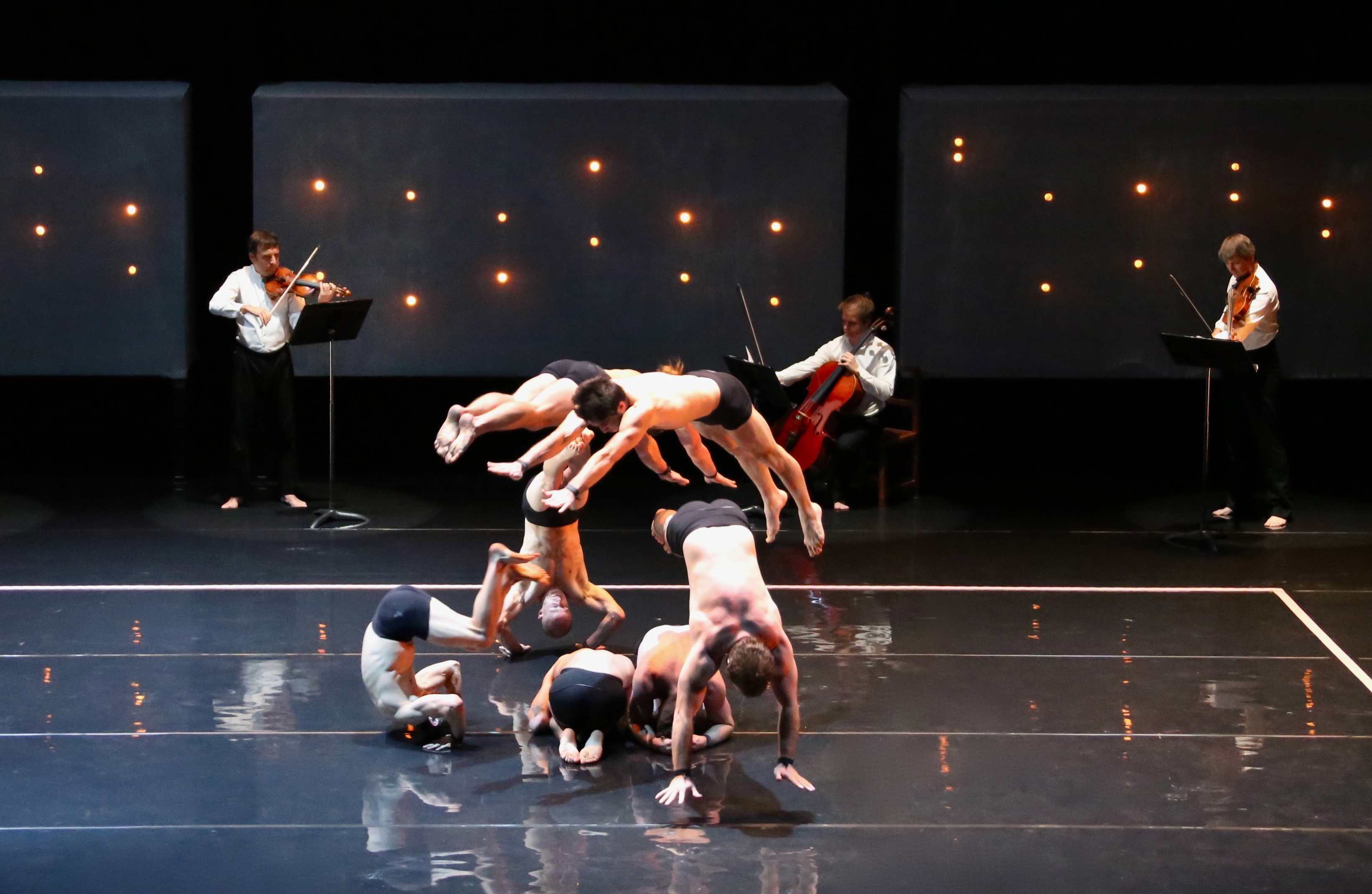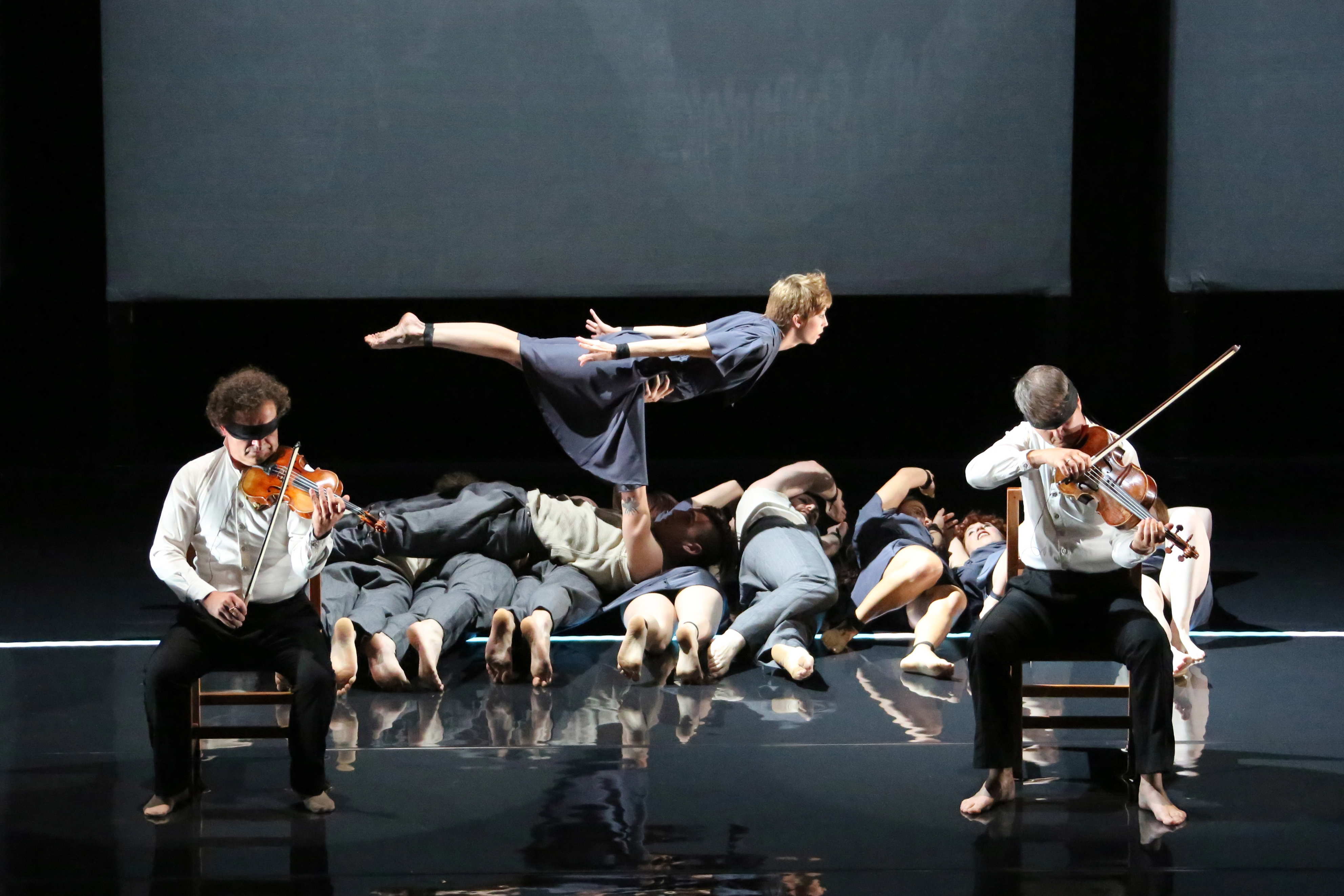Opus, Circa and Debussy String Quartet, Barbican | reviews, news & interviews
Opus, Circa and Debussy String Quartet, Barbican
Opus, Circa and Debussy String Quartet, Barbican
Circus acrobats and Shostakovich give each other a lift
Well! Just when you think you’ve constructed a nice tripartite schema for dance styles based on their relationship with the ground, along comes a company which tears up that rule book entirely.
Last week I theorized that contemporary dance goes down to the ground, ballet aims up off it, and Tanztheater Wuppertal walks, magnificently, on it. Then I saw Circa, an Australian contemporary circus ensemble, who on last night’s evidence can apparently dispense with the ground altogether and just fly through the air instead.
 Ok, I exaggerate. But not all that much: Circa’s performers are so impressive, they do appear to defy nature. Olympic gymnasts, contemporary ballerinas, and experienced yogis all possess analogous strength, flexibility and extreme elevation, but what sets the circus performers apart is their lack of framework: there seem to be no disciplinary conventions bounding their movement in space. As a result, their skill is almost eerie: when they spring and hover for a second parallel to the floor, before flipping silkily over to their feet, or when one runs fleetly up another’s back to pause, poised, standing on his shoulders, they seem like creatures from another element.
Ok, I exaggerate. But not all that much: Circa’s performers are so impressive, they do appear to defy nature. Olympic gymnasts, contemporary ballerinas, and experienced yogis all possess analogous strength, flexibility and extreme elevation, but what sets the circus performers apart is their lack of framework: there seem to be no disciplinary conventions bounding their movement in space. As a result, their skill is almost eerie: when they spring and hover for a second parallel to the floor, before flipping silkily over to their feet, or when one runs fleetly up another’s back to pause, poised, standing on his shoulders, they seem like creatures from another element.
The aim of circus has always been to astonish and delight with the nearly-impossible: Circa go further by harnessing their fey skills to a more serious artistic purpose. They are performing at the Barbican this week with the Debussy Quartet who play Shostakovich (the Eighth, Eleventh and Fifth quartets) live on stage, a physical space-sharing that, unlike much dance, weights both music and musicians equally – this is very much a double-headliner. There is a wonderful similitude too between the virtuosity of the string quartet and the physical virtuosity of acrobats; both seem to manipulate time, to redraw space. The fey, spiky, if you like extreme, power of Shostakovich allows the physical extremeness of circus to hint at extremes of emotion, of human nature, of history in vignettes that are powerful because expressive and suggestive, not mimetic. But it's not all one way: the exuberance, the lightness of circus reminds us that Shostakovich is far from unremittingly dark.


Reading a definite allegory of 20th-century history or human nature into this performance would be taking it too far: its strength lies in presenting powerful music and powerful dance alongside each other, giving both equal weight and equal space, and allowing their interaction to create a rich world of suggestion and sensation.
- Opus is at the Barbican until 22 February.
rating
Explore topics
Share this article
The future of Arts Journalism
You can stop theartsdesk.com closing!
We urgently need financing to survive. Our fundraising drive has thus far raised £49,000 but we need to reach £100,000 or we will be forced to close. Please contribute here: https://gofund.me/c3f6033d
And if you can forward this information to anyone who might assist, we’d be grateful.

Subscribe to theartsdesk.com
Thank you for continuing to read our work on theartsdesk.com. For unlimited access to every article in its entirety, including our archive of more than 15,000 pieces, we're asking for £5 per month or £40 per year. We feel it's a very good deal, and hope you do too.
To take a subscription now simply click here.
And if you're looking for that extra gift for a friend or family member, why not treat them to a theartsdesk.com gift subscription?
more Dance
 'We are bowled over!' Thank you for your messages of love and support
Much-appreciated words of commendation from readers and the cultural community
'We are bowled over!' Thank you for your messages of love and support
Much-appreciated words of commendation from readers and the cultural community
 Peaky Blinders: The Redemption of Thomas Shelby, Rambert, Sadler's Wells review - exciting dancing, if you can see it
Six TV series reduced to 100 minutes' dance time doesn't quite compute
Peaky Blinders: The Redemption of Thomas Shelby, Rambert, Sadler's Wells review - exciting dancing, if you can see it
Six TV series reduced to 100 minutes' dance time doesn't quite compute
 Giselle, National Ballet of Japan review - return of a classic, refreshed and impeccably danced
First visit by Miyako Yoshida's company leaves you wanting more
Giselle, National Ballet of Japan review - return of a classic, refreshed and impeccably danced
First visit by Miyako Yoshida's company leaves you wanting more
 Quadrophenia, Sadler's Wells review - missed opportunity to give new stage life to a Who classic
The brilliant cast need a tighter score and a stronger narrative
Quadrophenia, Sadler's Wells review - missed opportunity to give new stage life to a Who classic
The brilliant cast need a tighter score and a stronger narrative
 The Midnight Bell, Sadler's Wells review - a first reprise for one of Matthew Bourne's most compelling shows to date
The after-hours lives of the sad and lonely are drawn with compassion, originality and skill
The Midnight Bell, Sadler's Wells review - a first reprise for one of Matthew Bourne's most compelling shows to date
The after-hours lives of the sad and lonely are drawn with compassion, originality and skill
 Ballet to Broadway: Wheeldon Works, Royal Ballet review - the impressive range and reach of Christopher Wheeldon's craft
The title says it: as dancemaker, as creative magnet, the man clearly works his socks off
Ballet to Broadway: Wheeldon Works, Royal Ballet review - the impressive range and reach of Christopher Wheeldon's craft
The title says it: as dancemaker, as creative magnet, the man clearly works his socks off
 The Forsythe Programme, English National Ballet review - brains, beauty and bravura
Once again the veteran choreographer and maverick William Forsythe raises ENB's game
The Forsythe Programme, English National Ballet review - brains, beauty and bravura
Once again the veteran choreographer and maverick William Forsythe raises ENB's game
 Sad Book, Hackney Empire review - What we feel, what we show, and the many ways we deal with sadness
A book about navigating grief feeds into unusual and compelling dance theatre
Sad Book, Hackney Empire review - What we feel, what we show, and the many ways we deal with sadness
A book about navigating grief feeds into unusual and compelling dance theatre
 Balanchine: Three Signature Works, Royal Ballet review - exuberant, joyful, exhilarating
A triumphant triple bill
Balanchine: Three Signature Works, Royal Ballet review - exuberant, joyful, exhilarating
A triumphant triple bill
 Romeo and Juliet, Royal Ballet review - Shakespeare without the words, with music to die for
Kenneth MacMillan's first and best-loved masterpiece turns 60
Romeo and Juliet, Royal Ballet review - Shakespeare without the words, with music to die for
Kenneth MacMillan's first and best-loved masterpiece turns 60
 Help to give theartsdesk a future!
Support our GoFundMe appeal
Help to give theartsdesk a future!
Support our GoFundMe appeal

Add comment